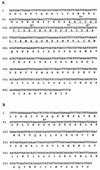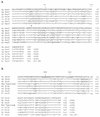Alterations in topoisomerase IV and DNA gyrase in quinolone-resistant mutants of Mycoplasma hominis obtained in vitro
- PMID: 9736554
- PMCID: PMC105824
- DOI: 10.1128/AAC.42.9.2304
Alterations in topoisomerase IV and DNA gyrase in quinolone-resistant mutants of Mycoplasma hominis obtained in vitro
Abstract
Mycoplasma hominis mutants were selected stepwise for resistance to ofloxacin and sparfloxacin, and their gyrA, gyrB, parC, and parE quinolone resistance-determining regions were characterized. For ofloxacin, four rounds of selection yielded six first-, six second-, five third-, and two fourth-step mutants. The first-step mutants harbored a single Asp426-->Asn substitution in ParE. GyrA changes (Ser83-->Leu or Trp) were found only from the third round of selection. With sparfloxacin, three rounds of selection generated 4 first-, 7 second-, and 10 third-step mutants. In contrast to ofloxacin resistance, GyrA mutations (Ser83-->Leu or Ser84-->Trp) were detected in the first-step mutants prior to ParC changes (Glu84-->Lys), which appeared only after the second round of selection. Further analysis of eight multistep-selected mutants of M. hominis that were previously described (2) revealed that they carried mutations in ParE (Asp426-->Asn), GyrA (Ser83-->Leu) and ParE (Asp426-->Asn), GyrA (Ser83-->Leu) and ParC (Ser80-->Ile), or ParC (Ser80-->Ile) alone, depending on the fluoroquinolone used for selection, i.e., ciprofloxacin, norfloxacin, ofloxacin, or pefloxacin, respectively. These data indicate that in M. hominis DNA gyrase is the primary target of sparfloxacin whereas topoisomerase IV is the primary target of pefloxacin, ofloxacin, and ciprofloxacin.
Figures




References
-
- Belland R J, Morrison S G, Ison C, Huang W H. Neisseria gonorrhoeae acquires mutations in analogous regions of gyrA and parC in fluoroquinolone-resistant isolates. Mol Microbiol. 1994;14:371–380. - PubMed
MeSH terms
Substances
Associated data
- Actions
- Actions
LinkOut - more resources
Full Text Sources

